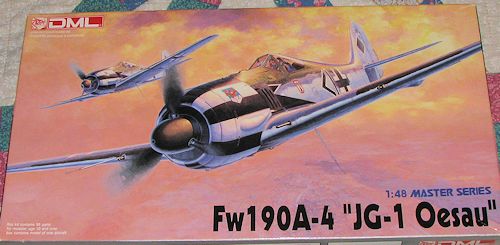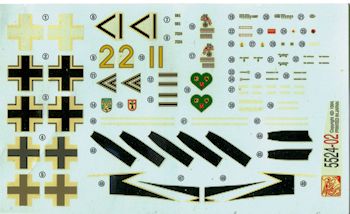
DML (Dragon) 1/48 FW-190A-4 "JG-1 Oesau"
| KIT #: | 5524 |
| PRICE: | $5.00 at a swap meet |
| DECALS: | Three options |
| REVIEWER: | Scott Van Aken |
| NOTES: | 1994 boxing |

| HISTORY |
Introduced in July 1942, the Fw 190 A-4 was equipped with the same engine and basic armament as the A-3. Updated radio gear, the FuG 16Z, was installed replacing the earlier FuG VIIa. A new, short "stub" vertical aerial mount was fitted to the top of the tailfin, a configuration which was kept through the rest of the production Fw 190s. In some instances, pilot-controllable engine cooling vents were fitted to the fuselage sides in place of the plain slots. Some A-4s were outfitted with a special Rüstsatz field conversion kit, comprising the fitting of a pair of under-wing Werfer-Granate 21 (BR 21) rocket mortars, and were designated Fw 190 A-4/R6. However, the A-4's main improvement was the number of Umrüst-Bausätze factory-refit package enhanced versions.
The U1 was outfitted with an ETC 501 rack under the fuselage. All armament except for the MG 151 cannon was removed. The U3 was very similar to the U1, and later served as the Fw 190 F-1 assault fighter. Some U3s used for night operations had a landing light mounted in the leading edge of the left wing-root. The U4 was a reconnaissance fighter, with two Rb 12.4 cameras in the rear fuselage and an EK 16 or Robot II gun camera. The U4 was equipped with fuselage-mounted 7.92 mm (.312 in) MG 17s and 20 mm MG 151 cannon. The U7 was a high-altitude fighter, easily identified by the compressor air intakes on either side of the cowling. Adolf Galland flew a U7 in the spring of 1943.
The A-4/U8 was the Jabo-Rei (Jagdbomber Reichweite, long-range fighter-bomber), adding a 300 L (80 US gal) drop tank under each wing, on VTr-Ju 87 racks with duralumin fairings produced by Weserflug, and a centreline bomb rack. The outer wing-mounted 20 mm MG FF/M cannon and the cowling-mounted 7.92 mm (.312 in) MG 17 were removed to save weight. The A-4/U8 served as the model for the Fw 190 G-1.
A new series of easier-to-install Rüstsatz field kits began to be produced in 1943. The first of these, the A-4/R1, was fitted with a FuG 16ZY radio set with a Morane "whip" aerial fitted under the port wing. These aircraft, called Leitjäger or Fighter Formation Leaders, could be tracked and directed from the ground via special R/T equipment called Y-Verfahren. More frequent use of this equipment was made from the A-5 onwards. The Fw 190A-4 could achieve 1,700 hp (2,100 with MW-50 boost). Its maximum speed was 416 mph (670 km/h) at 20,590 ft (6,250 m). Operational ceiling was 37,400 ft (11,400 m). Normal range was 497 miles (800 km). Normal takeoff weight was 8,378 lb (3,800 kg). A total of 976 A-4s were built between June 1942 and March 1943.
| THE KIT |
This is of the first properly done FW-190s in 1/48, the Trimaster/DML kit. After the initial release of these kits by Trimaster with metal landing gear and a rather high price, they were reissued without the metal gear under the DML label. Since then, DML has been remarketed as Dragon. It still has the photo etch and you get two frets of the stuff in this one. It is mostly used for interior bits like the armored head rest, seat harness, instrument panel, and side consoles. In fact, there is no plastic instrument panel or head rest so you have to use p.e.
This is the last of the 'short fuselage FW-190As and is similar to the earlier versions in several areas. Though some A-4 variants used the earlier wheels, this seems to have been changed during production. The kit comes with both styles. This one has the smaller upper cowling as it still uses the smaller cowl guns, but it does have the wing guns in the outer position so has the appropriate shell ejector chute insert. It also uses the later wheels.
Thanks to the p.e., the cockpit is well done and few will want to replace it with aftermarket. The cowling is a bit complex with four pieces making up the cowling itself and three inserts for the engine exhaust. The A-4 variant still used the small inner doors. The prop is one of those deals with separate blades that some of us dislike and they are not keyed. The canopy can be posed open or closed as one wishes.
There are some neat unused options on the sprues for this one including a set of longer fuselage halves, upper cowling and other bits, however, since I bought this one 'used', the previous owner had already removed many of the parts from the sprues and that includes any of the unneeded bits. A bomb rack is also included. Not included is any sort of drop tank, which I thought was pretty standard stuff.
 Instructions
are well done and include Gunze and Italeri (Model Master) paint references. The
decal sheet has seen better days, having dried and cracked in the twenty years
since it was printed. Markings are for two RLM 74/75/76 aircraft an done in
white. One is the box art plane from JG-1 with the white and black striped
cowling. The second JG 1 plane has a yellow rudder and does not have the
distinctive cowling. It was flown by Josef Wurmheller and has his score on the
rudder. Perhaps the decals can be saved with a clear coat, but I'll be looking
for aftermarket replacements. Fortunately, the FW-190A has been well represented
in the aftermarket community.
Instructions
are well done and include Gunze and Italeri (Model Master) paint references. The
decal sheet has seen better days, having dried and cracked in the twenty years
since it was printed. Markings are for two RLM 74/75/76 aircraft an done in
white. One is the box art plane from JG-1 with the white and black striped
cowling. The second JG 1 plane has a yellow rudder and does not have the
distinctive cowling. It was flown by Josef Wurmheller and has his score on the
rudder. Perhaps the decals can be saved with a clear coat, but I'll be looking
for aftermarket replacements. Fortunately, the FW-190A has been well represented
in the aftermarket community.
| CONCLUSIONS |
This particular kit will make into a nice model, but has been eclipsed in terms of ease of construction by newer kits from Hasegawa themselves. However, if you run across one at a good price, then by all means pick it up. It still makes a nice model and will add to your early 190A collection.
| REFERENCES |
http://en.wikipedia.org/wiki/Focke-Wulf_Fw_190
2014 Thanks to me for getting this one on sale. If you would like your product reviewed fairly and fairly quickly, please
contact the editor or see other details in the
Note to
Contributors.